Class 6 Science Chapter 3 Question Answers - Separation of Substances
Short Answer Questions
Q1: What is done in threshing? How can it be done?
Ans: In threshing, the stalks are beaten to free the grain seeds. Threshing can be done with the help of bullocks or machines.
Q2: Which types of impurities can be separated by hand-picking?
Ans: Hand-picking is used to separate slightly large-sized impurities. It is used when the quantity of impurities is not very large.
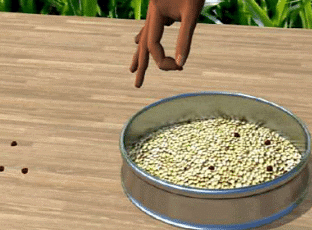 Process of Hand picking
Process of Hand picking
Q3: Why is separating different components of a mixture necessary?
Ans:
- To separate two different but useful components.
- To remove impurities or non-useful components from a mixture.
Q4: What do you mean by winnowing? Explain with an example.
Ans: Winnowing is separating the heavier and lighter components of a mixture by wind or by blowing air. For example-separating a mixture of sawdust and sand.
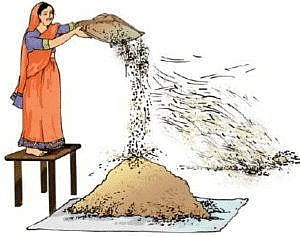
Q5: How is sieving used to separate particles of a mixture? Give example.
Ans: Sieving allows the fine particles to pass through the holes of a sieve while bigger impurities remain on sieve. E.g. separating bran from flour.
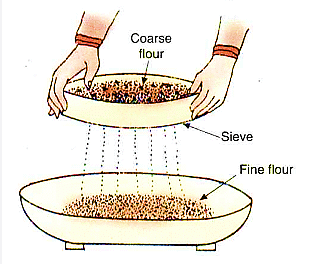 Q6: What is a saturated solution?
Q6: What is a saturated solution?
Ans: When no more solute (e.g. Salt) can be dissolved in the amount of solvent (e.g. Water) taken, the solution is said to be saturated solution.
Q7: What happens when steam comes in contact with the metal plate cooled with ice?
Ans: When steam comes in contact with the metal plate cooled with ice, it condenses and forms liquid water.
Q8: What is condensation?
Ans: The process of conversation of water vapour into its liquid form is called condensation.
Q9: By which process salt, sand and water can be separated?
Ans: Salt, sand and water can be separated by decantation, filtration, evaporation followed by condensation.
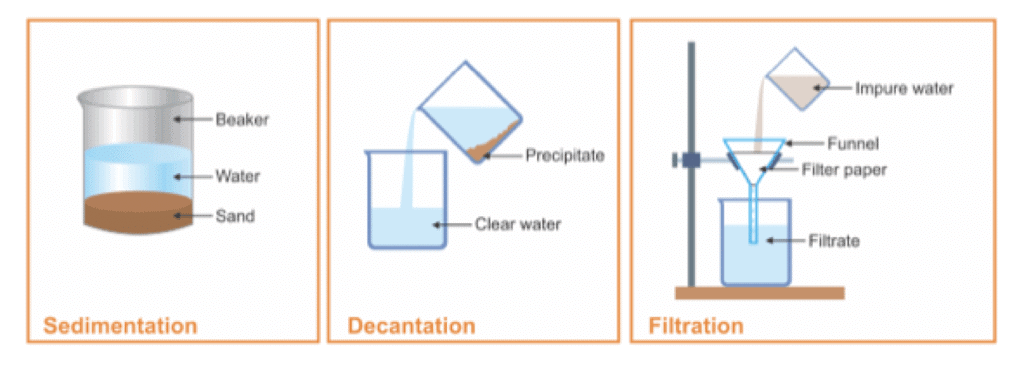
Q10: What is the difference between evaporation and condensation?
Ans: The process of conversion of water into its vapour is called evaporation. The process of converting water vapour into its liquid form is called condensation.
Q11: What is sedimentation?
Ans: When the heavier component of a mixture settles after water is added to it, the process is called sedimentation.
Q12: Write the name of the method for separating-
a) Salt from salt water solution.
b) Wheat from a mixture of wheat and rice.
Ans:
a) Evaporation.
b) Handpicking.
Q13: Which of the following is true :
a) Flour is sieved to separate impurities.
b) At a given temperature, a saturated solution can dissolve more of the solute.
Ans:
a) True
Sieving is a common method used to separate impurities such as bran, husks, or other large particles from flour. This process ensures that the flour is finer and purer for cooking or baking purposes.
b) False
A saturated solution has dissolved the maximum solute it can hold at a given temperature. Any additional solute will not dissolve unless the temperature or solvent amount is increased.
Q14: What is the role of decantation in separating mixtures?
Ans: Decantation is used to separate a liquid from a solid that has settled at the bottom of the container. For example, pouring out clear water from a mixture of water and sand after the sand has settled.
Q15: Why is handpicking not suitable for separating salt from sand?
Ans: Handpicking is not suitable for separating salt from sand because the particles of salt and sand are too small and similar in size, making it impossible to pick them out by hand.
Long Answer Questions
Q1: How is common salt obtained from the sea?Ans :
- Sea water contains many salts mixed in it.
- When seawater is allowed to stand in shallow pits, water gets heated by sunlight and slowly turns into water vapour, through evaporation.
- In a few days, water is evaporated completely leaving behind solid salts.
- Common salt is obtained from a mixture of salts by further purification.
Q2: Differentiate between sedimentation and decantation with a suitable example.
Ans:
Sedimentation: This is when heavier parts of a mixture settle down at the bottom. For example, if you mix sand and water and leave it undisturbed, the sand will settle at the bottom.
Decantation: This is when you separate the liquid part from a mixture after the heavier parts have settled at the bottom. For example, once the sand has settled in the sand-water mixture, you can pour the water into another container, leaving the sand behind.
i) Sand and husk
ii) Wheat, sugar and stalk
iii) Water and petrol
iv) Rice and salt
v) Sand and salt
Ans:
i) Sand and husk: Use winnowing. This method separates the husk, which is lighter, from the sand by blowing air through the mixture.
ii) Wheat, sugar, and stalk: First, use winnowing to remove the stalks, which are lighter. Then, use a sieve to separate the wheat from the sugar, as they are different sizes.
iii) Water and petrol: Use a separating funnel because water and petrol do not mix. The funnel allows the two layers to separate, and then you can drain each liquid separately.
iv) Rice and salt: Use sieving to separate the rice from the salt. The sieve allows the smaller salt particles to pass through while holding back the larger rice grains.
v) Sand and salt: Mix them with water so that the salt dissolves. Then, use sedimentation and decantation to remove the sand. Finally, evaporate the water to get the salt back.
Q4: Explain the method of separation of solid-liquid mixtures.Ans:
Filtration: This method uses filter paper to separate a solid from a liquid when the solid particles are too big to pass through the paper.
Centrifugation: For mixtures where solid particles are too small to be filtered, centrifugation is used. It spins the mixture at high speed, causing the solid particles to separate from the liquid based on size, shape, and density.
Sedimentation and Decantation: Heavy solid particles in a liquid can settle at the bottom over time. The clear liquid on top can then be poured off.
Q5: Describe the process of evaporation and how it is used to separate a solid dissolved in a liquid. Provide an example involving salt and water.
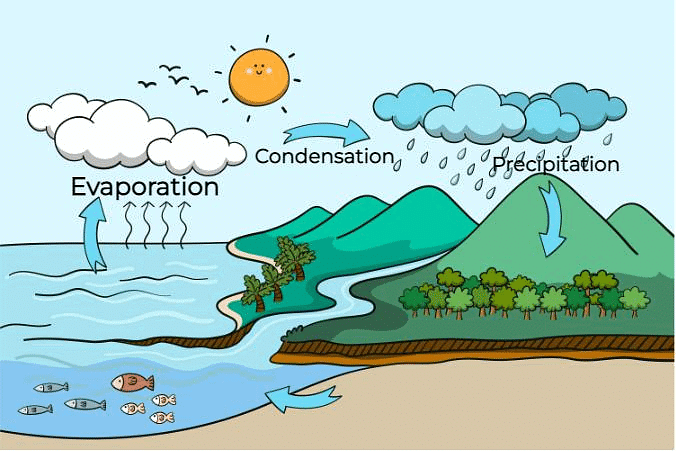 Ans:
Ans:
- Evaporation is the process where a liquid turns into vapour, leaving dissolved solids behind.
- To separate salt from saltwater using evaporation, heat the saltwater in a container.
- As the water evaporates, it turns into steam, leaving the salt behind.
- This method is used to produce common salt from seawater.
- Seawater is placed in shallow pits and heated by sunlight.
- The water evaporates, leaving solid salts, which are then collected and purified.
- Evaporation is a simple and effective way to separate dissolved solids from liquids, widely used in industries like salt production.
|
100 videos|261 docs|49 tests
|
FAQs on Class 6 Science Chapter 3 Question Answers - Separation of Substances
| 1. What are the different methods of separating substances? |  |
| 2. How does filtration work in separating substances? |  |
| 3. What is distillation and how is it used in separating substances? |  |
| 4. Explain how chromatography is used to separate substances. |  |
| 5. How can evaporation be used to separate substances? |  |


























